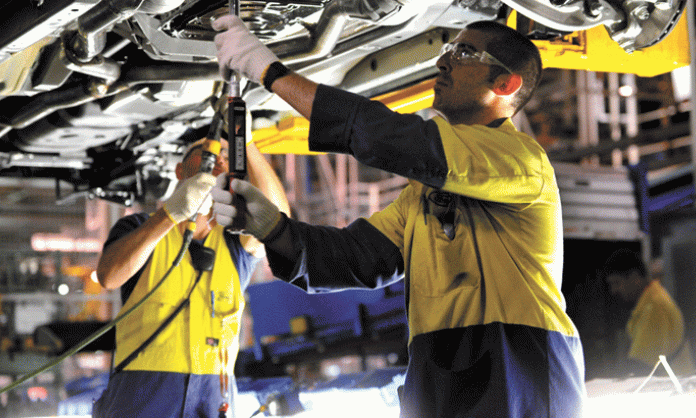She works for a car company, mainly imports but a bit of manufacturing. He works in a Melbourne factory, for one of the biggest automotive component makers in the world. Between them they hold a banner that reads:
Australian Made Parts
Australian Made Cars
Save Our Kids Future
Save Our Jobs
It’s the week before Christmas, and we’re outside the Liberal Party headquarters. A dismal hundred protesters have gathered for a rally called by the Australian Manufacturing Workers Union.
Holden has announced that it is shutting down its manufacturing plants in Australia. Three thousand jobs will be scrapped and maybe, depending on how the dominoes fall, another 40,000 jobs will disappear.
This is an attack on working class lives that many will never recover from. When Mitsubishi closed its Adelaide factory in 2004, 71 percent of workers ended up on lower pay, many scrabbling for casual or part time jobs – and that was at the peak of the mining boom.
So why aren’t we in the streets in our thousands? Why aren’t we organising mass strikes? We’re not even blockading Liberal Party headquarters. No one seems to have confidence we can do anything to affect things. Most conversations are on the theme of “It’s terrible, what can I say? …” with a shrug of resignation.
I ask people whether they are personally affected. One man points at the company logo for a parts supplier on his fluoro jacket, and remarks, “Used to be 24 hour shifts. Now, just day shift and they cut back the afternoon … What can we do?” That shrug again.
“What can we do?” is the right question. But to answer it, we need to understand how we came to this.
How militancy was lost
In the 1970s the metal workers’ unions were among the most militant in the country, with a section of the leadership declaring themselves communist. But the chink in the armour was always a dangerous streak of nationalism. Rather than “workers of the world, unite”, the dominant idea was “save Australian industry”. Only a minority of revolutionaries warned that the problems of capitalism were international, so the solutions had to be international.
The nationalist argument started from a real problem. Then as now, a minerals boom leading to a strong Australian dollar was putting manufacturing under pressure. The union leaders’ explanation was a conspiracy theory.
Foreign companies wanted to trash Australian manufacturing, they said. The evil foreigners wanted to reduce the country and simply use Australia as a “giant quarry”. They had no vision beyond that, and neither did Malcolm Fraser’s government, and both would let manufacturing stagnate.
So it was up to the unions to ensure the survival of the sector by making it more competitive. To be internationally competitive, we had to accept job cuts and restructure the industry. So from the very first, they offered us a diabolical logic: cut jobs to save jobs.
The unions produced a series of pamphlets, the first called Australia Uprooted. These aimed to convince union activists. Once union activists had been won over, the AMWU made a deal with the metals bosses in 1981. Then, when Labor won the 1983 election, the gist was embodied in the notorious Prices and Incomes Accord between the Hawke government and the ACTU.
Union leaderships policed a “no strike” policy and helped to craft a series of “industry plans” – each cutting jobs while claiming to save industry. The fascination with plans betrayed the fact that union leaders across the board were giving up traditions of struggle. The sharp 1981 recession had convinced traditional lefties like Laurie Carmichael that just fighting for jobs would bankrupt companies.
Work on the plans started out as an alternative to the free market. But after the 1983 election, the actual implementation drew closer and closer to free market logic. First it was a national pay deal, then trade-offs and then each industry had its own deal. Next came “enterprise bargaining” and finally the fatal move towards individual contracts.
The force behind this transition was a series of government-sponsored industry plans, starting with the 1985 “Button Plan”. And over the 30 years since, workers have done everything they told us to: participation in job cuts, restructuring, employer plans to intensify work.
But now, rather than the industry being saved, it is being restructured out of existence. Senator Button has long since departed the scene, and a gloating Tony Abbott is preparing to put the boot in. We’re left shaking our heads while our leaders propose more of the same!
A game we can’t win
“International competitiveness” is a game workers can’t win. US auto workers’ wages and benefits have been slashed. General Motors is telling workers in South Korea that decent wages and strong union organisation mean they aren’t profitable to employ. The same message goes out to workers in Germany. A thousand are thrown on the scrap heap in Brazil, while in Thailand and South Africa, workers are told to stay clear of the unions or else.
The unions were right to reject the free market. The market allocates resources according to what’s profitable, not on the basis of human need. But the government plans turned out to be another road to the same place. The plans were supposed to make possible a viable industry, but they turned out to be pathetic deals to prop up the bosses from moment to moment, until the relentless free market finally struck a death blow. And that blow could succeed because the best fighting force – the organised workers – had been run down.
Socialists support union campaigns to save jobs, but we don’t think you get very far trying to save jobs through protection. Tariffs raise the price of imports, so who ends up paying? Our fellow workers overseas and Australian consumers, mostly workers. This might save a temporary handful of jobs, but what it mostly does is hand over funding to bosses who need it because they couldn’t get their act together to run the company. Behind the clever gimmicks, industry plans have proved little different.
There are more problems with protectionist schemes. They offer local solutions (for Australia, for Victoria, for Queensland etc.) when the problems are global. What we need are international campaigns in which workers in other countries are seen as part of the solution, not as a threat. This sounds challenging, but it’s far from impossible. During the 1998 MUA dispute, US wharfies in Los Angeles picketed Australian ships, chanting, “MUA – here to stay! No scab cargo in LA!”
In 2012 General Motors announced it was slashing 1,800 jobs at the Sao Josedos Campos plant in Brazil. More than 2,000 workers struck for a day and occupied a major highway. The government and the company were forced to make concessions.
Factory occupations in the past, such as the battle at Cockatoo Island, have usually failed to reach their objectives because by the time they started to mobilise, the state of the company and workforces was dire.
But they put the bosses on notice that workers will fight, that to attack our jobs will cost them. After that, the employers will think twice. And instead of shrugging, we can point in a direction that can win.









